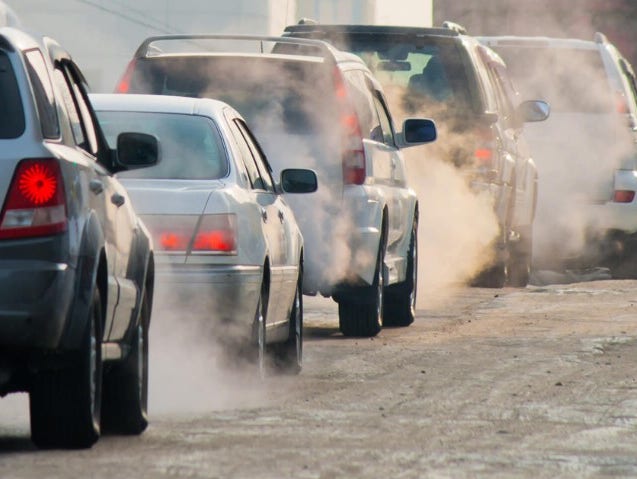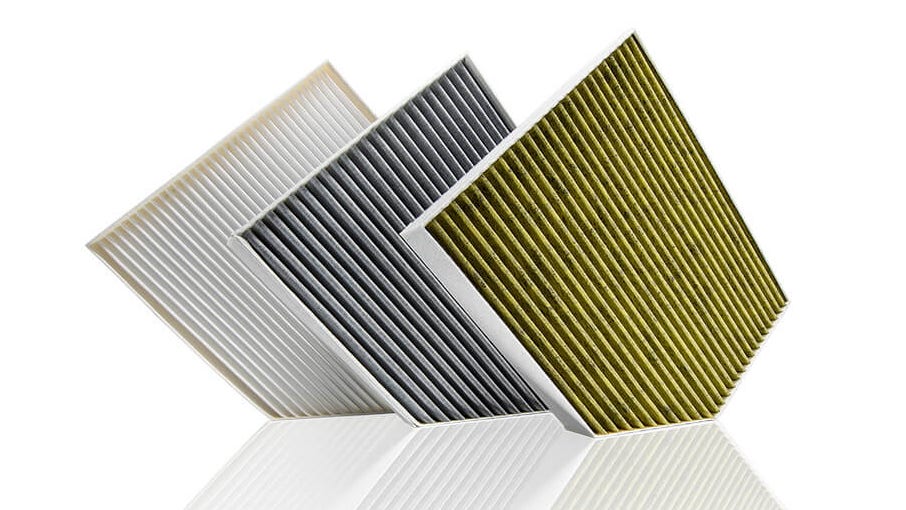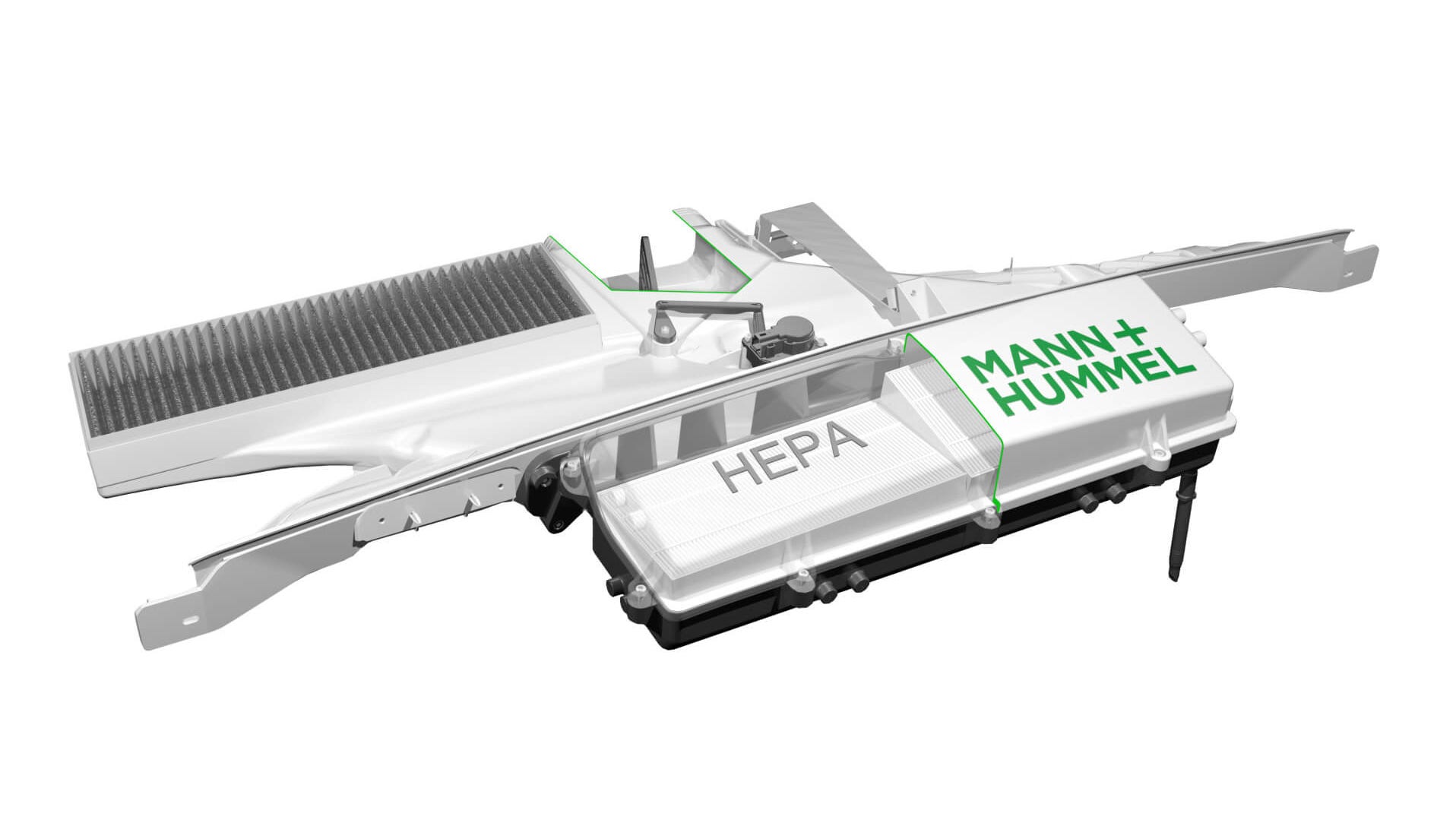Air pollution in cars: Causes & solutions for better vehicle interior air quality (VIAQ)
According to the U.S. Environmental Protection Agency (EPA), indoor air pollution is often up to five times higher than outdoor levels. Outdoors, harmful gases such as ozone or nitrogen oxides, and pollutants such as fine dust or microorganisms are much better diluted or dispersed. However, indoors, for instance in a car, the concentration of these pollutants keeps increasing - just like when you travel by car during summer vacation. During a traffic jam, the driver and passengers can spend hours in the vehicle, leaving them exposed to poor air quality inside the car.
Air pollution has been declared the primary environmental risk by the World Health Organization (WHO), and MANN+HUMMEL considers this issue a top priority. With our filtration products, we provide effective solutions for cleaner air - also when it comes to vehicle pollution - outside and inside the car. Take our cabin air filters and systems, for example. They protect drivers and passengers from numerous pollutants in the incoming air by providing a better VIAQ and ensuring cleaner air throughout the journey.
Air pollution in cars: The invisible danger

According to the WHO, around 99% of humanity worldwide lives in places where the air quality is classified as hazardous. As the International Council on Clean Transportation (ICCT) research institute found out, in Germany alone, around 13,000 people die each year from car exhaust pollution - almost five times more than from traffic accidents.
Experts believe that fine dust and especially ultrafine particles can penetrate into the blood vessels and cause damage to every organ. On average, poor outdoor and indoor air quality reduces life expectancy by three years. Every year, around 7 million people worldwide die as a direct result of air pollution, including 600,000 children. According to the Organization for Economic Cooperation and Development (OECD), there is a serious risk that these figures will double by 2050.
In addition, air quality is also negatively impacted by harmful gases such as ozone, VOC (Volatile Organic Compounds), nitrogen oxide and carbon dioxide. Moreover, poor air quality in cars not only affects the health of the driver and passengers, but also the driver's ability to drive.
Why is good air quality in cars so crucial?
The smallest space in which people spend the most time is the car cabin. Although every modern vehicle has an air conditioning system that supplies and recirculates air, according to the U.S. EPA the concentration of pollutants in the car can be up to five times higher than outside. This is because up to 540,000 liters of air can flow into the vehicle per hour. Pollutants from outside can enter the vehicle and remain there for a long time. As a result, air pollution inside the car increases, while VIAQ decreases.
What is air pollution and where does it come from?
Air pollution is a mixture of various airborne liquid, solid and gaseous pollutants. While these pollutants can also result from natural events such as forest fires, air pollution is mainly a man-made problem.
Air pollution in cars is most commonly caused by emissions from vehicles, as well as by industrial and agricultural processes. In addition, emissions from private households, public facilities and many other sources increase air pollution, both inside and outside the vehicle:

- Emissions from surrounding vehicles enter the interior and circulate there. Additional pollutants are also released from the tank and engine compartment (for example through evaporation).
- Materials inside the vehicle can also have an enormous impact on pollutant and harmful gas levels in the interior. Plasticizers - for example in seat covers, fittings, steering wheels or cable insulation - can be emitted by direct sunlight and contribute to an increased air pollution inside the car.
- Viruses, fungi and bacteria also pose a health hazard that is exacerbated by improperly maintained, or even misused air conditioning systems in the vehicle. This is another reason why we actively participated in the introduction of the VDI/ZDK 6032 guideline, which redefines the recommendations for regular filter changes and air-conditioning system cleaning.
- Defective pollen filters, as well as pollen carried into the vehicle interior via clothing, dirt on shoes or other objects, can lead to an accumulation of allergens in the vehicle cabin.
- The carbon dioxide content of the interior air becomes higher over time because all vehicle occupants share the same, often scarce, air. If ventilation or air conditioning is used to reduce the carbon dioxide content, new pollutants and harmful gases can enter the interior from the outside, impairing the air quality within the car.
What are the different types of pollutants and harmful gases?
We distinguish three types of pollutants in the air:
Particle size plays a decisive role, especially in the case of particulate matter. Fine dust particles and other pollutants are currently divided into four main PM (Particulate Matter) categories:

- Particles with a size of >10 μm (micrometers) are so large that they can penetrate through the nose or throat before entering even deeper into the body.
- The next smallest particles belong to the PM10 category, i.e. smaller than 10 μm. Often, they are trapped in the throat, but under some circumstances they can penetrate into the main bronchi.
- Particles of size PM2.5 are smaller than 2.5 μm. They are so small that they can bypass most of the body's defense mechanisms and reach much deeper into the bronchial system.
- Finally, the most dangerous category is ultrafine particles with a size of less than 0.1 micrometers (PM0.1). They are so tiny that they can penetrate unhindered into the bloodstream, are carcinogenic, and can cause severe damage to internal organs.
The effects of bad air quality in the car on humans
When it comes to clean air in cars, it's about much more than simply the feel-good factor. Air pollution inside the car has a direct effect on health and, furthermore, it creates a higher potential for accidents.
Pollutants and noxious gases in the indoor air can:
- Trigger or exacerbate respiratory and cardiovascular diseases
- Increase the heart rate and blood pressure
- Impair concentration, and thereby massively deteriorate driving ability
Taking effective countermeasures and precautions can help prevent these various negative effects.
Solutions for improving air quality in cars
To help reduce vehicle pollution in cars or commercial vehicles, while also increasing VIAQ, there are many solutions available. Some are very simple and highly effective.

- Safety distance: The further away a vehicle drives from other vehicles, the less likely it is that car emissions will enter its interior.
- Close windows when the car is stationary, whether parking or in a traffic jam. Ideally, switch the air conditioning to automatic mode.
- Use less congested roads if possible. It’s also better to travel on routes with fewer traffic lights. According to Spiegel, English researchers found that the pollution of the air inside a car skyrockets by a factor of up to 29 when starting up, compared to when it’s moving. In general, the researchers measured about six times higher pollution at traffic signals.
- Avoid air fresheners, such as fragrance trees, as these are usually heavily contaminated with volatile organic compounds (VOCs).
- Keep vehicle interiors clean: Whether dust, food residues or moisture, potential sources of pollutants and harmful gases should be removed as quickly and as thoroughly as possible.
- Observe ideal cabin temperature: This should be between 21 and 23 degrees.
- Regular maintenance and filter change: According to guideline VDI/ZDK 6032, filters should be changed at least every 12 months, ideally combined with cleaning the air-conditioning system. This is the only way to effectively exclude health risks.
- Use high-quality cabin air filters of the latest generation from MANN+HUMMEL - whether for cars or commercial vehicles, for protection against viruses, fine dust, bioaerosols or harmful gases, to optimize VIAQ.
Our cabin air filters for better air quality inside the car
MANN+HUMMEL offer cabin air filters and systems for original equipment and cabin air filter elements for the aftermarket. With us, our partners and customers can ensure cleaner air in the vehicle whilst also meeting the highest VIAQ standards.
We are constantly developing new high-performance filters for cars, commercial vehicles and off-road vehicles. This enables us to respond to increased requirements by utilizing our experience and innovation at any time, even for new drive systems.

Our portfolio currently includes:
- Particle filters made of synthetic filter material for reliable filtration of up to 95% of PM10* particles from the air. These are used, for example, as classic pollen filters in cars and commercial vehicles.
- Combi filters, consisting of synthetic filter material and activated carbon layers, which can filter up to 95% of PM10 particles, whilst also reducing bad odors and adsorbing harmful gases such as nitrogen oxides.
- High-performance filters with bio-functional filter media that can filter particles, bind allergens, reduce bad odors and harmful gases, but also protect against the growth of bacteria and fungi on the filter media.
Our latest nanofiber filter media provide consistently high separation performance over the entire filter service life. This means they can reliably filter even PM1 particles from the air over the long term. In combination with bio-functional media, the nanofiber filter thus becomes a powerful cabin air filter that can also act as an allergen filter to help bind allergens and filter pollutants such as airborne viruses aerosols, pollen. etc. They also help prevent the harmful growth of bacteria and fungi on the filter.
*The ePM10 classification according to DIN EN ISO 16890 applies to particle filters, combination filters and high-performance filters with a biofunctional layer.
Cabin air filter from MANN+HUMMEL to fight against air pollution in cars
MANN+HUMMEL offers solutions that prevent air pollution from entering the vehicle from the outside. The goal: reach optimum VIAQ and achieve the best possible air quality inside the car. Even the very worst air quality outside should have no effect inside. Our cabin air filters serve four purposes:
- They effectively protect drivers and vehicle occupants from pollutants in the long term.
- They improve comfort and well-being in the vehicle by providing fresher and cleaner air.
- They increase safety by improving visibility and reducing or even preventing allergic reactions.
- They protect the air conditioning system from contamination and deposits.
Our experience for the automotive air filtration of the future
For more than 80 years, we have been filtration specialists with one mission: separate the useful from the harmful. At MANN+HUMMEL, our employees work on new, innovative methods for effective air filtration. We have been equipping clean rooms and operating theaters with highly efficient air filters for over 60 years. This many years of experience also flows into our development of cabin air filters for cars, commercial and offroad vehicles - whether with classic or alternative drives.
Future-proof indoor air filtration: MANN+HUMMEL shows the way
 HEPA cabin air filter
HEPA cabin air filter
Our experience in equipping hospitals has shown that our HEPA filters** offer ultimate protection through air filtration in order to provide the very highest level of clean room quality. This level of quality is absolutely essential in operating theaters, for example. HEPA filters from MANN+HUMMEL can filter more than 99.95% of solid and liquid particles from the air, with a protection level of H14 even being able to filter up to 99.995% of pollutants from the air. This ultimately makes it the most effective filtration method, especially when combatting ultrafine particles. Although these tiny particles make up only 10% of the mass of fine dust, they account for 90% of air pollution - with serious consequences for our health.
At MANN+HUMMEL, we therefore utilize HEPA filters as part of a three-stage cabin air filter system. Whether to improve cleanliness, odor protection or visibility, using a prefilter alongside the appropriate cabin air filter, in combination with the HEPA filter, always leads to the best possible vehicle interior air quality.
 Smart cabin air filter system
Smart cabin air filter system
Smart HEPA filter systems are also designed to ensure that filtration only takes place when needed. An algorithm controls filtration, air supply and room temperature - not only protecting the valuable filters, but also optimizing energy or gasoline consumption, thereby increasing the vehicle's range. With MANN+HUMMEL, the future of cabin air filtration looks bright.
MANN+HUMMEL combines filtration expertise with digitalization to create a unique air quality experience in cars. Digital Solutions For Cleaner Cabin Air make this possible. The result: smart cabin air filtration and monitoring that gives our partners and customers total control.
With MANN+HUMMEL Data Services, drivers and passengers are always in the picture. They receive a detailed report on the air quality of their journeys, are informed about necessary maintenance measures and can book a service appointment directly. Improving air quality is made possible by our ideas and constant drive for innovation and improvement. Our products give drivers and co-drivers the opportunity to intuitively, immediately, clearly and sustainably influence the air quality inside cars and commercial vehicles.
**High Efficiency Particulate Air Filter, individually tested according to ISO 29463 and DIN EN 1822

Further information
Would you like more information about our cabin air filters for cars and commercial vehicles? Our Whitepaper gives you an overview of what we do for cleaner air in vehicles.

